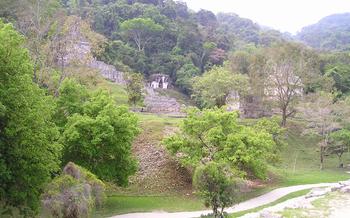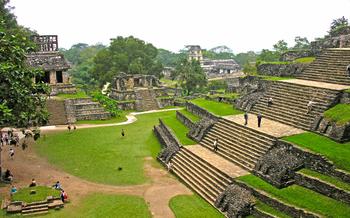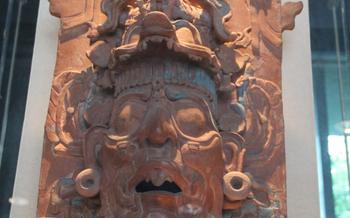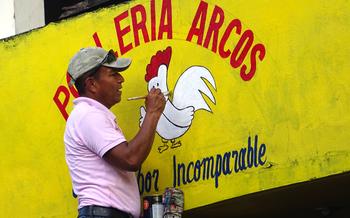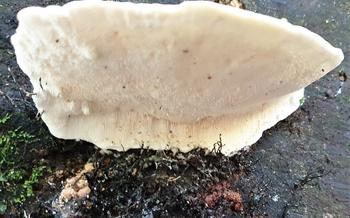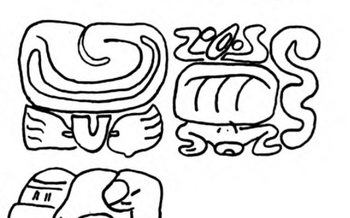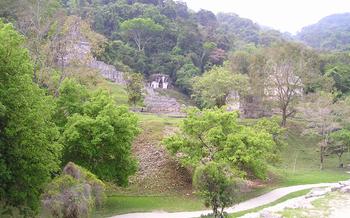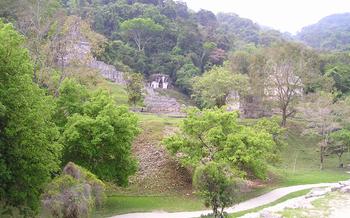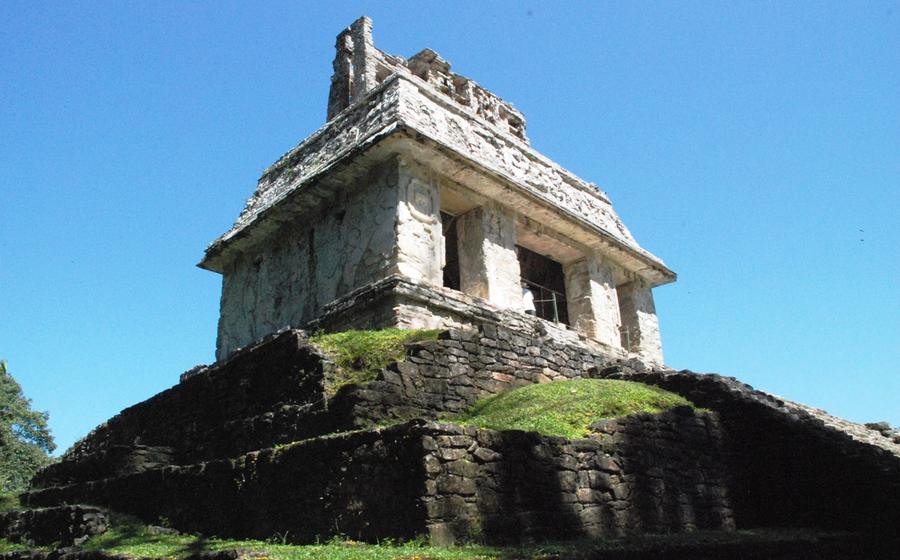
Templo del Sol
- Templo del Sol: A Monumental Palace in Palenque
- Unraveling the Mystery: Discover the History Behind Templo del Sol
- Ascending to the Temple: A Journey Through Time
- Unveiling the Ceiling Masterpieces: Murals and Stucco Reliefs
- Exploring the Temple's Interior: A Realm of Ancient Rituals
- The Temple's Architectural Wonders: A Showcase of Mayan Ingenuity
- Unveiling the Royal Tomb: A Glimpse into Mayan Rulers' Afterlife
- A Walk Through History: Exploring the Surrounding Archaeological Site
- A Thriving Cultural Heritage: The Living Maya in Palenque
- A Journey Through Time: The Palenque Museum
- Getting There: A Guide for Seamless Travel
- Planning Your Visit: Essential Tips for a Rewarding Experience
- Local Cuisine: A Culinary Adventure in Palenque
- Accommodation Options: A Range of Choices for Every Traveler
- Insider Tip: Unforgettable Sunrises and Stargazing
Templo del Sol: A Monumental Palace in Palenque
The ** the architectural prowess and cultural significance of the ancient Maya civilization. Located within the heart of the Palenque archaeological site, this majestic structure served as a royal palace and a sacred temple, embodying the power and prestige of the Maya rulers.
The historical significance of the Templo del Sol is deeply intertwined with the lineage of the Maya kings. Constructed during the reign of K'inich Janaab' Pakal I, one of the most renowned rulers of Palenque, the temple was a symbol of his authority and a testament to his achievements. Its construction marked a period of prosperity and artistic flourishing for the Maya civilization.
Architecturally, the Templo del Sol showcases the Maya's mastery of construction techniques. Built on a raised platform, the temple features a towering facade adorned with intricate carvings and bas-reliefs depicting scenes from Maya mythology and history. Its iconic stepped pyramid design rises towards the sky, creating a sense of awe and grandeur.
The interior design of the temple reflects the Maya's profound understanding of astronomy and cosmology. The main chamber is adorned with vibrant murals depicting the Maya creation myth and the journey of the sun god, Kinich Ahau. The walls are lined with stucco reliefs showcasing scenes of royal ceremonies, battles, and rituals, offering a glimpse into the rich cultural and religious life of the ancient Maya.
Situated within the archaeological site of Palenque, the Templo del Sol forms part of a sprawling complex of temples, palaces, and plazas. Its proximity to other significant structures, such as the Temple of the Cross, the Palace, and the Great Plaza, highlights its central role in the political and religious life of the ancient city.
Unraveling the Mystery: Discover the History Behind Templo del Sol
The Templo del Sol stands as a testament to the ingenuity and beliefs of the ancient Maya. Inhabited by the Maya as early as 100 BC, Palenque was a thriving city-state by the 7th century AD. The construction of the temple is attributed to the powerful ruler K'inich Janaab' Pakal, who reigned from 615 to 683 AD. It is believed that the temple served as a sacred place of worship and a tomb for Pakal himself.
Archaeological excavations have unearthed a wealth of artifacts and inscriptions that shed light on the history and significance of the Templo del Sol. These findings suggest that the temple was a multi-functional structure that served various purposes, including religious ceremonies, astronomical observations, and political gatherings. The ongoing research and unanswered questions surrounding the temple continue to fuel the fascination of archaeologists and historians, making it a site of immense historical and cultural importance.
Ascending to the Temple: A Journey Through Time
The ascent to the Templo del Sol is an experience that transports visitors back in time, evoking the footsteps of ancient Maya priests and rulers. The grand staircase, with its imposing steps, serves as a symbolic passageway between the earthly realm and the sacred domain of the gods. Each step represents a challenge, a test of devotion and worthiness.
Overcoming these challenges, visitors are rewarded with access to the temple's summit, a place of unparalleled spiritual and cultural significance. The orientation of the temple, precisely aligned with the cardinal directions, imbues the ascent with a profound sense of cosmic harmony.
At the temple's summit, a breathtaking panorama unfolds. The vast expanse of the surrounding jungle, the intricate tapestry of the archaeological site, and the distant silhouettes of the Maya Mountains create a breathtaking vista. This vantage point offers a glimpse into the grandeur of the ancient Maya civilization and their profound connection to the natural world.
Unveiling the Ceiling Masterpieces: Murals and Stucco Reliefs
The Templo del Sol's interior is a testament to the artistic mastery of the Maya civilization. The ceiling is adorned with vibrant murals that depict scenes from the Maya creation myth, accompanied by intricate stucco reliefs that add depth and dimension to the artwork.
The murals, painted in vivid hues of red, blue, yellow, and green, narrate the story of the Maya gods and their role in the creation of the world. One of the most striking murals depicts the Maize God, a central figure in Maya mythology, emerging from a conch shell, symbolizing the birth of life.
The stucco reliefs, meticulously crafted from a mixture of lime, sand, and water, showcase a variety of motifs and symbols. They depict human figures, animals, and mythological creatures, each holding significant meaning within the Maya belief system. The reliefs also feature geometric patterns and intricate scrollwork, adding a touch of elegance and sophistication to the overall design.
The creation of these masterpieces involved a complex process that required skilled artisans to work in harmony. The murals were first sketched onto the plaster surface using natural pigments derived from plants and minerals. The stucco reliefs were then applied, using molds or freehand techniques, to create the intricate designs and three-dimensional forms.
The restoration of these remarkable artworks is an ongoing effort, with teams of conservators working diligently to preserve and protect the delicate paintings and reliefs. Their efforts have been instrumental in ensuring that these ancient masterpieces continue to captivate and inspire visitors from around the world.
Exploring the Temple's Interior: A Realm of Ancient Rituals
Venturing into the main chamber of Templo del Sol is like stepping into a sacred realm where ancient rituals once unfolded. The dimly lit interior exudes an aura of mystery and reverence, beckoning you to uncover the secrets that lie within. Archaeologists have uncovered a treasure trove of artifacts and offerings within the temple, providing valuable insights into the religious practices and rituals performed by the Maya. These offerings, often consisting of jade, ceramic vessels, and precious objects, were believed to appease the deities and ensure their continued favor.
The temple served as a stage for various ceremonies and rituals that played a crucial role in Mayan society. From elaborate coronation ceremonies to sacred dances and prayers, the temple witnessed a rich tapestry of spiritual expressions. It is believed that the Maya performed rituals here to honor and communicate with their deities, seeking guidance, protection, and prosperity. The temple's acoustics, carefully designed to amplify sound, further enhanced the intensity and solemnity of these sacred ceremonies.
In addition to its religious significance, the temple also functioned as a political and administrative center. Rulers and priests used this sacred space to conduct important meetings, make decisions, and discuss matters of governance. The temple's strategic location within the city allowed for easy access and facilitated the smooth functioning of the Mayan society.
The Temple's Architectural Wonders: A Showcase of Mayan Ingenuity
The Templo del Sol showcases the remarkable architectural prowess of the ancient Maya. Its construction exemplifies their mastery of various techniques and their deep understanding of engineering principles.
One of the temple's most distinctive features is its unique corbelled arch construction. This technique involves stacking stones in a gradually inward-sloping manner, creating a self-supporting archway without the use of a keystone. The corbelled arches of the Templo del Sol are particularly impressive, demonstrating the Maya's ability to create sturdy and aesthetically pleasing structures.
Another notable aspect of the temple's architecture is its complex water management system. The Maya constructed an elaborate network of channels and reservoirs to collect and distribute rainwater throughout the site. This system not only provided a vital water supply but also helped to prevent flooding and erosion.
The temple's orientation also reveals the Maya's understanding of astronomy. The structure is precisely aligned with the cardinal directions, suggesting that it may have been used for astronomical observations or ceremonies. This alignment also allowed sunlight to illuminate the temple's interior during specific times of the year, creating a dramatic and awe-inspiring effect.
Finally, the temple is adorned with a wealth of artistic elements, including sculptures, carvings, and friezes. These intricate decorations depict various deities, rulers, and symbolic motifs, providing valuable insights into Mayan mythology, history, and artistic traditions. The sheer number and quality of these artworks further demonstrate the skill and artistry of the Maya.
Unveiling the Royal Tomb: A Glimpse into Mayan Rulers' Afterlife
In the heart of Templo del Sol lies a hidden chamber that holds the secrets of ancient Mayan rulers' passage into the afterlife. The discovery of this royal tomb in 1952 marked a pivotal moment in understanding Mayan funerary practices and beliefs.
The elaborate burial chamber, adorned with intricate carvings and vibrant murals, transported archaeologists and historians back in time, revealing the opulence and reverence with which Mayan rulers were laid to rest. The tomb's contents, including precious jade ornaments, ceramic vessels, and skeletal remains, provided invaluable insights into the rituals and customs associated with death and rebirth in Mayan culture.
The identity of the ruler entombed within remains a subject of ongoing research, with scholars proposing various theories based on the tomb's artifacts and historical records. The possibility that the tomb belongs to Pacal the Great, one of the most renowned rulers of Palenque, has generated considerable excitement and speculation among archaeologists.
The discovery of the royal tomb has not only shed light on Mayan funerary practices but has also fueled our understanding of the intricate social and political structures that governed this ancient civilization. It stands as a testament to the enduring legacy of the Maya, whose beliefs and traditions continue to captivate and inspire to this day.
A Walk Through History: Exploring the Surrounding Archaeological Site
Beyond the Templo del Sol, the archaeological site of Palenque offers a wealth of other captivating structures that provide a glimpse into the ancient Maya civilization. The grand plaza, with its vast expanse, once hosted significant ceremonies and public gatherings. Surrounding this central space, numerous temples, palaces, and pyramids stand as testaments to the architectural prowess of the Maya. Each edifice possesses its own unique characteristics and intricate details, revealing the artistry and ingenuity of its creators.
Among the notable structures, the Temple of the Cross, with its remarkably preserved stucco reliefs depicting mythological scenes, stands as a testament to the artistic achievements of the Maya. The Palace, once the residence of Palenque's rulers, showcases intricate carvings and friezes, offering insights into the opulence and grandeur of their daily lives. The Temple of the Inscriptions, renowned for its elaborate hieroglyphic texts, provides valuable information about Palenque's history and rulers, contributing to our understanding of this ancient civilization.
Another significant feature of the site is the ball court, a large open space where the ancient Maya engaged in a ritual game known as pok-ta-pok. This game held both religious and social significance, and the court's impressive size and elaborate decorations attest to its importance in Maya society.
The archaeological site of Palenque is not only a treasure trove of ancient ruins but also a place of natural beauty. Nestled amidst lush vegetation, the site's surroundings provide a tranquil ambiance that enhances the overall experience. The verdant forest surrounding the ruins is home to a diverse array of flora and fauna, adding to the site's ecological importance.
A Thriving Cultural Heritage: The Living Maya in Palenque
Palenque is not just an archaeological wonder; it is also home to a vibrant Maya community that proudly carries on the traditions and legacy of their ancestors. In the surrounding villages and towns, you can immerse yourself in the living culture of the Maya people. Attend traditional ceremonies and festivals, such as the Fiesta de la Virgen de Guadalupe, where colorful processions, music, and dance fill the streets. Visit local markets to witness the exchange of goods and the bustling energy of everyday life. Take part in cooking classes to learn about traditional Maya cuisine and taste the flavors of the region. Engage with local artisans who create beautiful textiles, pottery, and wood carvings, showcasing their skills and artistic heritage. By interacting with the living Maya community, you gain a deeper understanding of their culture, preserving and celebrating the rich traditions that have endured for centuries.
A Journey Through Time: The Palenque Museum
A visit to the Templo del Sol is incomplete without exploring the Palenque Museum. Situated near the archaeological site, this museum serves as a repository of artifacts and relics unearthed during excavations. Through interactive exhibits and educational displays, the museum brings the ancient Maya civilization to life. Visitors can marvel at intricate sculptures, ceramics, and jade ornaments that adorned the temples and palaces of Palenque. The museum also sheds light on the daily lives, customs, and beliefs of the Maya people.
The museum's collection includes a replica of the iconic death mask of King Pakal, discovered in his tomb beneath the Templo del Sol. This exquisite mask, crafted from jade and shell, is a testament to the artistry and craftsmanship of the Maya. The museum also displays a variety of funerary objects and offerings, providing insights into the Maya's beliefs about the afterlife.
The Palenque Museum plays a crucial role in preserving and showcasing Mayan culture for future generations. It serves as a reminder of the ingenuity, creativity, and spiritual beliefs of this ancient civilization. Through its exhibits and educational programs, the museum fosters a deeper understanding of the Maya's legacy and its enduring impact on the world.
Getting There: A Guide for Seamless Travel
Reaching Palenque is a journey that blends modern convenience with historical charm. The city is accessible by air, land, and sea, offering travelers a range of options to suit their preferences and budget.
By Air:
Palenque International Airport (PQM) is the main gateway to the city. It receives regular flights from major cities in Mexico, including Mexico City, Cancun, and Villahermosa. From the airport, you can take a taxi or shuttle to your hotel in Palenque, which takes about 15 minutes.
By Land:
For a more scenic and immersive experience, consider traveling to Palenque by land. Buses are a popular and affordable option, with regular services from neighboring cities like San Cristóbal de las Casas, Mérida, and Campeche. The journey offers stunning views of the lush countryside and local villages.
By Sea:
If you're seeking a unique adventure, opt for a boat trip to Palenque. Ferries operate from the port city of Frontera, located about 100 kilometers away. The journey takes approximately 3 hours and offers a glimpse into the region's beautiful coastline and mangrove forests.
Accessibility:
Palenque is generally accessible for visitors with disabilities. The airport and bus stations have ramps and elevators, while many hotels offer wheelchair-accessible rooms. However, navigating the archaeological site may pose some challenges due to uneven terrain and narrow passageways.
Local Transportation:
Once in Palenque, you can easily get around using taxis, tuk-tuks, or colectivos (shared vans). Taxis are readily available and relatively inexpensive. Tuk-tuks offer a fun and breezy way to explore the city, while colectivos provide a budget-friendly option for longer distances.
Recommended Routes:
For a comprehensive visit, consider combining different modes of transportation. Arrive by air or land, explore the city and archaeological site, and then embark on a boat trip to nearby attractions like the Yaxchilán ruins or the Lacandon Jungle. This will allow you to experience the diverse landscapes and cultural heritage of the region.
Planning Your Visit: Essential Tips for a Rewarding Experience
To make the most of your visit to Templo del Sol and the surrounding archaeological site, careful planning is crucial. Consider the following tips:
Ideal time to visit: The most favorable time to visit Palenque is during the dry season, which typically runs from November to April. During this period, the weather is generally dry and pleasant, allowing for comfortable exploration.
Recommended duration: To fully immerse yourself in the history and culture of Palenque, plan to spend at least two to three days exploring the site. This will give you ample time to visit Templo del Sol, other notable structures, and the museum.
Packing essentials: Be sure to pack comfortable clothing and footwear suitable for walking on uneven surfaces. Sunscreen, insect repellent, and a hat are essential for protection against the tropical sun and insects. Bring a camera to capture the stunning sights and memories.
Safety considerations: Palenque is generally safe for travelers. However, as with any destination, it's wise to exercise caution and be aware of your surroundings. Avoid walking alone at night, and keep valuables secure. Travel insurance is recommended for peace of mind.
By following these tips, you'll set yourself up for a rewarding and memorable experience at Templo del Sol and the ancient city of Palenque.
Local Cuisine: A Culinary Adventure in Palenque
Palenque's culinary scene is a vibrant tapestry of flavors and aromas, deeply rooted in Mayan traditions. Local cuisine showcases a harmonious blend of fresh ingredients, vibrant spices, and unique cooking techniques, offering a delightful journey for food enthusiasts.
Begin your culinary adventure with the iconic pejelagarto, a succulent fish dish that embodies the region's aquatic heritage. Savor the smoky flavors of chilmole, a traditional sauce made from roasted chilies and spices, accompanying grilled meats and vegetables. Indulge in the richness of tamales, cornmeal dumplings stuffed with savory fillings, wrapped in banana leaves and steamed to perfection.
For a taste of street food, explore the bustling markets and local eateries. Try antojitos, a variety of snacks and small plates, including crispy tacos, flavorful tlayudas (large tortillas topped with beans, cheese, and meat), and refreshing esquites (corn kernels slathered in chili, lime, and mayonnaise).
Don't miss the chance to visit local restaurants that showcase regional specialties. Savor the aromatic cochinita pibil, a slow-roasted pork dish infused with achiote paste, or tantalize your taste buds with poc chuc, grilled pork marinated in citrus and spices.
For a truly immersive experience, visit the local markets. Browse the vibrant stalls laden with fresh produce, exotic fruits, fragrant spices, and artisanal products. Engage with friendly vendors, learn about traditional cooking methods, and pick up ingredients to create your own Mayan-inspired dishes.
Palenque's cuisine is a testament to the region's rich cultural heritage. Embark on a culinary adventure, indulge in the local flavors, and savor the essence of Mayan gastronomy in every bite.
Accommodation Options: A Range of Choices for Every Traveler
Palenque offers a diverse range of accommodation options to suit every traveler's budget and preferences. Budget-friendly travelers can opt for cozy hostels or guesthouses that provide basic amenities and a chance to mingle with fellow adventurers. Mid-range hotels offer more comfort and convenience, with air-conditioned rooms, private bathrooms, and often a swimming pool or restaurant. For a truly luxurious experience, splurge on a stay at one of Palenque's upscale resorts, which offer elegant rooms, world-class amenities, and stunning views of the surrounding rainforest. Regardless of your budget, booking your accommodation in advance is advisable, especially during peak tourist season, to secure your preferred choice and avoid disappointment.
Insider Tip: Unforgettable Sunrises and Stargazing
For an unforgettable experience, make sure to witness the sunrise from the summit of Templo del Sol. As the first rays of sunlight pierce through the horizon, casting a warm glow over the ancient ruins, you'll feel a sense of awe and wonder. The panoramic views from the temple's summit are simply breathtaking, offering a unique perspective of the surrounding jungle and the rising sun.
Palenque is also an ideal destination for stargazing enthusiasts. Far from the light pollution of cities, the night sky here reveals a mesmerizing spectacle of stars, planets, and constellations. Lie down on the temple's platform and let the cosmos captivate you. If you're lucky, you might even catch a glimpse of the Milky Way, stretching across the heavens like a celestial river.
To enhance your experience, consider joining a guided night tour. Knowledgeable guides will point out celestial wonders, share captivating stories about Mayan astronomy, and help you capture stunning photographs of the night sky. Whether you're a seasoned stargazer or a first-time observer, this experience will leave you with lasting memories.
